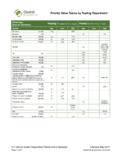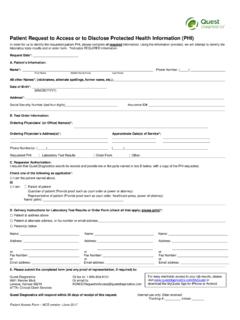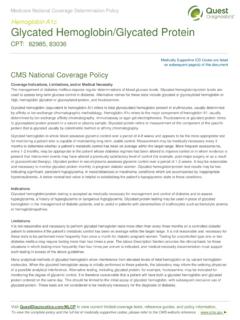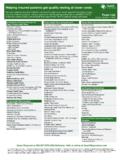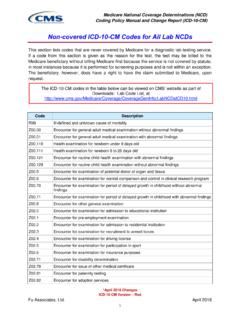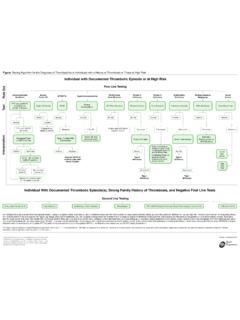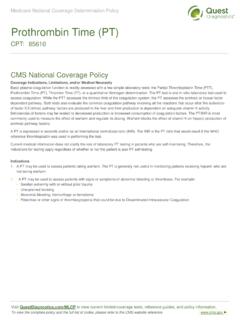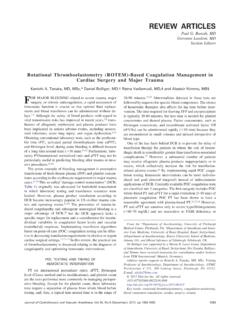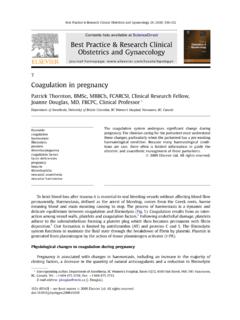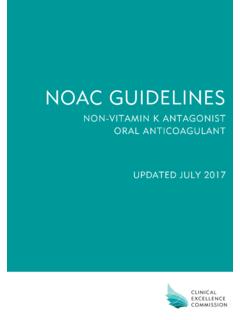Transcription of Partial Thromboplastin Time (PTT) - Quest Diagnostics
1 CPT:Medicare National Coverage Determination PolicyCMS National Coverage PolicyVisit view current limited coverage tests, reference guides, and policy view the complete policy and the full list of codes, please refer to the CMS website reference85730 Partial Thromboplastin Time (PTT) Coverage Indications, Limitations, and/or Medical NecessityBasic plasma coagulation function is readily assessed with a few simple laboratory tests: The Partial Thromboplastin Time (PTT),Prothrombin Time (PT), Thrombin Time (TT), or a quantitative fibrinogen determination. The PTT test is an in vitro laboratorytest used to assess the intrinsic coagulation pathway and monitor heparin therapy. PTT is most commonly usedto quantitate the effect of therapeutic unfractionated heparin and to regulate its dosing. Except during transitions between heparin and warfarin therapy, in general both the PTT and PT are not necessary together to assess theeffect of anticoagulation therapy. PT and PTT must be justified PTT may be used to assess patients with signs or symptoms of hemorrhage orthrombosis.
2 For example: Abnormal bleeding, hemorrhage or hematoma petechiaeor other signs ofthrombocytopeniathat could be due to Disseminated Intravascular coagulation Swollen extremity with or without prior PTT may be useful in evaluating patients who have a history of a condition known tobeassociated with the risk of hemorrhage or thrombosis that is related to the intrinsiccoagulationpathway. Such abnormalities may be genetic or acquired. For example: Dysfibrinogenemia; Afibrinogenemia(complete) Acute or chronic liver dysfunction or failure, including Wilson s disease Hemophilia Liver disease and failure; Infectious processes Bleeding disorders Disseminated intravascular coagulation Lupus erythematosusor other conditions associated with circulating inhibitors, , factor VIII Inhibitor, lupus-like anticoagulant Sepsis Von Willebrand sdisease Arterial and venous thrombosis, including the evaluation of hypercoagulablestates Clinical conditions associated with nephrosisor renal failure Other acquired and congenital coagulopathies as well as thrombotic PTT may be used to assess the risk of thrombosis or hemorrhage in patients who are going to have a medical intervention known to be associated with increased risk of bleeding or thrombosis.
3 An example is as follows: evaluation prior to invasive procedures or operations of patients with personal or family history of bleeding or who are on heparin The PTT is not useful in monitoring the effects of warfarin on a patient s coagulation routinely. However, a PTT may be ordered on a patient being treated with warfarin as heparin therapy is being discontinued. A PTT may also be indicated when the PT is markedly prolonged due to warfarin The need to repeat this test is determined by changes in the underlying medical condition and/or the dosing of Testing prior to any medical intervention associated with a risk of bleeding and thrombosis (other than thrombolytic therapy) will generally be considered medically necessary only where there are signs or symptoms of a bleeding or thrombotic abnormality ora personal history of bleeding, thrombosis or a condition associated with a coagulopathy. Hospital/clinic-specific policies, protocols, etc., in and of themselves, cannot alone justify CPT:CodeDescriptionMedicare National Coverage Determination PolicyThe ICD10 codes listed below are the top diagnosis codes currently utilized by ordering physicians for the limited coverage test highlighted above that are also listed as medically supportive under Medicare s limited coverage policy.
4 If you are ordering this test for diagnostic reasons that are not covered under Medicare policy, an Advance Beneficiary Notice form is required. *Note Bolded diagnoses below have the highest utilizationDisclaimer: This diagnosis code reference guide is provided as an aid to physicians and office staff in determining when an ABN (Advance Beneficiary Notice) is necessary. Diagnosis codes must be applicable to the patient s symptoms or conditions and must be consistent with documentation in the patient s medical record. Quest Diagnostics does not recommend any diagnosis codes and will only submit diagnosis informationprovided to us by the ordering physician or his/her designated staff. The CPT codes provided are based on AMA guidelines and are for informational purposes only. CPT coding is the sole responsibility of the billing party. Please direct any questions regarding coding to the payer being updated:Visit view current limited coverage tests, reference guides, and policy view the complete policy and the full list of codes, please refer to the CMS website reference , Quest Diagnostics , any associated logos, and all associated Quest Diagnostics registered or unregistered trademarks are the property of Quest Diagnostics .
5 All third-party marks and are the property of their respective owners. 2016 Quest Diagnostics Incorporated. All rights Other primary Other specified coagulation coagulation defect, Thrombocytopenia, Type 2 diabetes mellitus with Paroxysmal atrial Unspecified atrial Heart failure, Acute embolism and thrombosis of unspecified deep veins of unspecified lower Unspecified cirrhosis of Systemic lupus erythematosus, Pain in unspecified Chronic kidney disease, Shortness of Chest pain, Unspecified abdominal Spontaneous Abnormal coagulation Encounter for therapeutic drug level Long term (current) use of anticoagulants85730 Please refer to the Limitations or Utilization Guidelines section on previous page(s) for frequency information. 10/01/21 Partial Thromboplastin Time (PTT)
